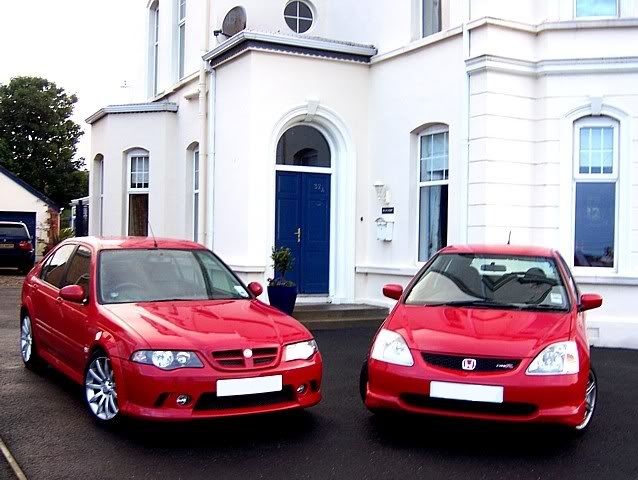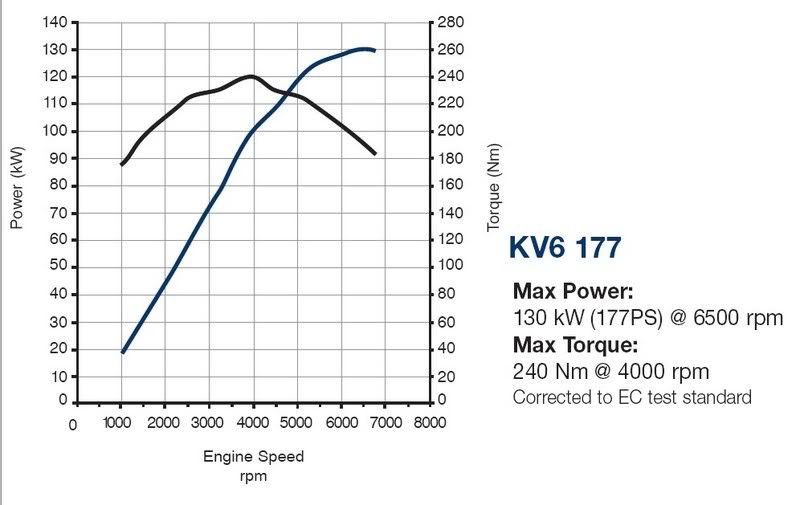Question about BHP + Torque
Discussion
Just wondering...
Q: Is it possible to merge both the BHP and Torque figure of a car into ONE performance figure, which would then allow 2 separate cars to be more easily compared?
For example:
(01-05) Civic Type R | 197bhp | 145lbft
(04-05) MGZS180 | 174bhp | 177lbft

I picked these 2 cars because I've owned one of them and driven the other at length. Both similar weight and performance - but one with higher bhp, and one with higher torque.
I don't have the mathematical ability to know the relationship between bhp and torque, or what factors would need to be applied to either bhp or torque in order for a single figure to work.
Q: Is it possible to merge both the BHP and Torque figure of a car into ONE performance figure, which would then allow 2 separate cars to be more easily compared?
For example:
(01-05) Civic Type R | 197bhp | 145lbft
(04-05) MGZS180 | 174bhp | 177lbft

I picked these 2 cars because I've owned one of them and driven the other at length. Both similar weight and performance - but one with higher bhp, and one with higher torque.
I don't have the mathematical ability to know the relationship between bhp and torque, or what factors would need to be applied to either bhp or torque in order for a single figure to work.
Yes, what actually determines performance is the average height of the used part of the power curve. So if you change up at 7000rpm and it drops you to 5000rpm, you want to take the average power generated between 5000 and 7000rpm.
Or to put it another way, the area under the used part of the power curve, divided by the difference between the gear ratios.
ETA: Unless, of course, you are accelerating from so slow that you can't use the top end of the rev range in first gear, or you don't know how to use a gearbox.
Or to put it another way, the area under the used part of the power curve, divided by the difference between the gear ratios.
ETA: Unless, of course, you are accelerating from so slow that you can't use the top end of the rev range in first gear, or you don't know how to use a gearbox.

Edited by kambites on Monday 28th July 09:07
kambites said:
Yes, what actually determines performance is the average height of the used part of the power curve. So if you change up at 7000rpm and it drops you to 5000rpm, you want to take the average power generated between 5000 and 7000rpm.
Or to put it another way, the area under the used part of the power curve, divided by the difference between the gear ratios.
ETA: Unless, of course, you are accelerating from so slow that you can't use the top end of the rev range in first gear, or you don't know how to use a gearbox.
How do you define the used part of the power curve? Or to put it another way, the area under the used part of the power curve, divided by the difference between the gear ratios.
ETA: Unless, of course, you are accelerating from so slow that you can't use the top end of the rev range in first gear, or you don't know how to use a gearbox.

Edited by kambites on Monday 28th July 09:07
manmaths said:
How do you define the used part of the power curve?
I define it as the part of the power curve that you're using when you drive. 
How much of the curve you have to use will depend on how closely spaced your gears are. The closer the gears, the less of the rev range you need to use so the closer you can stay to peak power (although of course changing gear takes time in itself).
hairykrishna said:
Assuming this isn't a troll to kick off the inevitable argument...
Power is already derived from torque. Power=(torque x rpm)/ 5252 (assuming lb/ft and horsepower as units).
I'm definitely not trolling. Just trying to understand more about the topic. I didn't know bhp was a measure of torque. Power is already derived from torque. Power=(torque x rpm)/ 5252 (assuming lb/ft and horsepower as units).
Can you apply your example to one of the cars I listed?
The MG has 174bhp and 177lbft. if power = (177 x 6500rpm) / 5252 I get 219 as my answer, but bhp is 174.
Also, if an engine is modified to increase torque does bhp always change too?
ETA I was assuming rpm meant max rpm which if I remember in the MG was about 6.5k or 7k. Using 7k in the equation gives an answer of 235.
You need to be careful of terminology. I think you're talking about peak torque and peak power. Increasing the torque at one point of the rev range will always increase power at that point of the rev range but will not necessary increase peak power because that might be at a different point, if that makes sense.
Peak torque actually tells you almost nothing about an engine's peak performance; what it does do is give you an indication of how well the engine will perform if you're not in the correct gear for optimal acceleration.
Peak torque actually tells you almost nothing about an engine's peak performance; what it does do is give you an indication of how well the engine will perform if you're not in the correct gear for optimal acceleration.
Edited by kambites on Monday 28th July 10:02
manmaths said:
I'm definitely not trolling. Just trying to understand more about the topic. I didn't know bhp was a measure of torque.
Can you apply your example to one of the cars I listed?
The MG has 174bhp and 177lbft. if power = (177 x 6500rpm) / 5252 I get 219 as my answer, but bhp is 174.
Also, if an engine is modified to increase torque does bhp always change too?
ETA I was assuming rpm meant max rpm which if I remember in the MG was about 6.5k or 7k. Using 7k in the equation gives an answer of 235.
You're using the wrong RPM. You don't achieve maximum torque at the RPM you're using in this instance.Can you apply your example to one of the cars I listed?
The MG has 174bhp and 177lbft. if power = (177 x 6500rpm) / 5252 I get 219 as my answer, but bhp is 174.
Also, if an engine is modified to increase torque does bhp always change too?
ETA I was assuming rpm meant max rpm which if I remember in the MG was about 6.5k or 7k. Using 7k in the equation gives an answer of 235.
Something like an S2000 will be nearer that mark where peak torque RPM and peak power RPM are very similar.
You need a power curve and gear ratios to logic it properly in terms of average power over an RPM range for a given gear.
vinnie01 said:
I always thought torque and horse power were seperate.
Power= how fastyour going when you hit the wall
torque = how much of the wall you pull down
It's a rubbish analogy really.Power= how fastyour going when you hit the wall
torque = how much of the wall you pull down
Engines generate torque by virtue of the fact that you're exerting a force on a lever (force on the piston, lever is the distance of the crank pin from the centreline). Power is torque with respect to engine speed.
The two are proportional when considering engine speed.
manmaths said:
I'm definitely not trolling. Just trying to understand more about the topic. I didn't know bhp was a measure of torque.
Can you apply your example to one of the cars I listed?
The MG has 174bhp and 177lbft. if power = (177 x 6500rpm) / 5252 I get 219 as my answer, but bhp is 174.
Also, if an engine is modified to increase torque does bhp always change too?
ETA I was assuming rpm meant max rpm which if I remember in the MG was about 6.5k or 7k. Using 7k in the equation gives an answer of 235.
As others have said, you're using the wrong rpm. Example dyno curve;Can you apply your example to one of the cars I listed?
The MG has 174bhp and 177lbft. if power = (177 x 6500rpm) / 5252 I get 219 as my answer, but bhp is 174.
Also, if an engine is modified to increase torque does bhp always change too?
ETA I was assuming rpm meant max rpm which if I remember in the MG was about 6.5k or 7k. Using 7k in the equation gives an answer of 235.

It's clear that the peak torque is much lower in the rev range than the peak power. As for the mod question - it depends what you mean by 'increase torque'. If the torque is increased at a given revs then the power at those revs also increases. This doesn't necessarily mean the peak power is increased.
hairykrishna said:
Power is already derived from torque. Power= torque x rpm x a constant
Don't ignor this (edited) reply. The power figure is already an attempt to combine the two values of torque and rpm but it usually only quoted for a specific rpm. The alternative would be to publish graphs or something like this:kambites said:
Yes, what actually determines performance is the average height of the used part of the power curve. ... Or to put it another way, the area under the used part of the power curve, divided by the difference between the gear ratios.
but I can't see it catching on.You just need to research the cars that you're interested in with no quick and easy answer.
Another way to look it is power is the "rate that torque is applied". A motorcycle engine may produce 200hp but it won't work in car weighing 1500kg because it doesn't have the torque to move the car at lower RPM. Likewise a 200hp car engine will have too much torque at lower rpm for the motorbike because the bike only weighs 200kg.
For max acceleration in any vehicle what you want is (flat) torque at 100% ft-lbs tyres can transmit to the road without spinning across the maximum operating RPM range of the engine. Forgetting about numbers for a moment, this for me represents the perfect torque delivery:

For max acceleration in any vehicle what you want is (flat) torque at 100% ft-lbs tyres can transmit to the road without spinning across the maximum operating RPM range of the engine. Forgetting about numbers for a moment, this for me represents the perfect torque delivery:
TA14 said:
hairykrishna said:
Power is already derived from torque. Power= torque x rpm x a constant
Don't ignor this (edited) reply. The power figure is already an attempt to combine the two values of torque and rpm but it usually only quoted for a specific rpm. The alternative would be to publish graphs or something like this
Gassing Station | General Gassing | Top of Page | What's New | My Stuff




